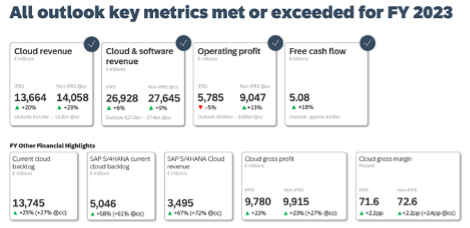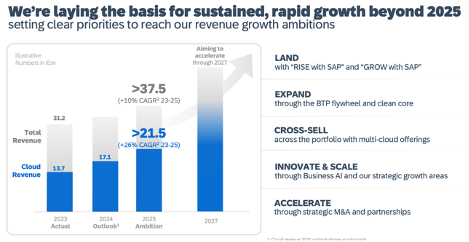The News
On January 23, 2024, SAP announced the results of its Q4 and fiscal year 2023, along with an update of the company’s 2025 ambition. The ambition includes a shift of focus on key strategic growth areas and a restructuring program. This program will cost around 2.2 billion dollar and affect about 8,000 employees. Notably, SAP does not look at lay-offs but a “voluntary leave program and internal re-skilling investments”. No details are known yet. One of the core investment areas going forward will be Business AI; in addition, the company will strive to capture organizational synergies, leverage AI-driven efficiencies and prepare the company for the expected growth.
Looking at the numbers, SAP had a very successful year, meeting or exceeding the outlook metrics set and communicated for 2023.

SAP key financial results FY 2023; source SAP
According to CEO Christian Klein, the “current cloud backlog increased by 27 percent to reach an all-time high” growth. This number and the cloud revenue are particularly driven by S/4HANA growth.
In addition, SAP communicated a bold outlook with a CAGR of 25 percent plus through 2025 and beyond.
Wall Street was excited.
The Bigger Picture
AI is the new cloud, currently the biggest thing since the invention of sliced bread. The industry is at the peak of an AI hype cycle. So far, we have seen a lot of low-hanging fruit being showcased while being promised an age of AI that “changes everything”.
According to the recently published results of the PWC annual global CEO surveyhttps://www.pwc.com/us/en/library/ceo-survey.html, around two thirds of CEOs believe that the use of generative AI
- will improve their company’s products or services significantly.
- will lead to it changing the ways it creates, delivers, and captures value,
- will increase the competitive intensity,
- and will require most of their workforce to reskill.
Again, all this without having seen more than above mentioned proverbial low-hanging fruit. For vendors, it is high time to produce and showcase business solutions that deliver to the high expectations; or else the trough of disillusions will be deep and painful.
Overall, the competition in the business applications market has become fiercer year by year. This does not only include the big vendors but increasingly also vendors that move up from the SMB business.
In addition, the business application market turned from an application market into a platform market, while requirements are changing faster and faster. This requires all vendors to stay – or become – very nimble.
My Analysis and Point of View
SAP has been pronounced a cloud laggard, not being innovative, and being a dying model times and again – mostly by some competitors and friendly-to-them pundits.
It is fair to say that SAP has proven again that it is not only not a zombie, but in fact continues to be a formidable company that helps its customers derive significant value from their investments. And not only this, but SAP continues to prove that a vendor can execute its own cloud transition while not only continuing to grow but also in a very profitable manner. One could argue that this transition started late, but hey, the execution is strong. This is evidenced by a continuously high gross margin – of which some cloud vendors can only dream – in combination with a continued revenue growth. On top of that, SAP is able to continuously accelerate both, cloud revenue and cloud margins, the latter again being considerably higher than some of the competitors.
Inevitably, AI has become a major topic for SAP as well. It is not for no reason that the company hired Walter Sun away from Microsoft to become the company’s new head of AI. An increased focus on AI also makes a lot of sense from a business point of view, as increasingly value for customers gets created by analyzing data for patterns very fast and offering solutions to questions in near real time, i.e., in very few seconds or sub second timeframes. In addition to this, the “conversation” becomes a more and more important user interface for business applications. Deeply ingraining AI into the software and enriching business capabilities or even enabling some that haven’t been possible before, is important for a company like SAP to stay relevant or even become more relevant. However, this also needs a focus on data and people. An AI that does not work on a foundation of good data has very limited benefit for customers. Similarly, if employees are not equipped to take advantage of AI-driven systems, there is not much value created for the customers. So, SAP needs to help its customers to solve these two problems that every customer has according to fellow analyst Josh Greenbaum, so that they do not look at a third one, which is cost, and avoid investments.
It will also be very interesting to see how SAP puts this into an industry strategy, as industry knowledge and capabilities have historically been one of SAP’s key strengths.
In contrast, the key priorities and strategies “for sustained, rapid growth beyond 2025” as laid out in the earnings presentation (pages 7 and 8) are largely horizontal.

SAP growth strategy for 2025 and beyond; source SAP
What I again miss is a statement towards CX, although one could argue that cross-selling across the portfolio covers this topic to some extent. Still, I am of the opinion that it needs constant repetition on board level to CX as an integral part of an offering that promises to cover end-to-end business processes, again, one of the five key problems that (not only) SAP customers have. And SAP is one of the very few companies that can make the promise of delivering industry-leading processes for a range of industries.

